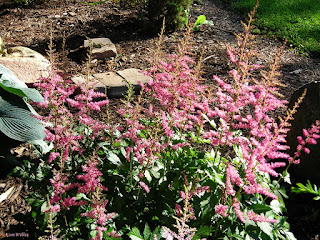Astilbe- An Astonishing
Perennial for Shade
 |
| Astilbe |
If you need color in a
semi-shady spot in summer and early fall then Astilbe is a plant you will want
to get to know. Astilbe, sometimes
called False Spirea, will wave its airy graceful flowers and bring those dull
spots to life. Astilbe has few disease
or insect problems and is resistant to deer and other animals.
Astilbe looks good in masses
of one color or mixed with perennials such as hosta that also appreciate
moisture. Astilbe can furnish the shade
at the feet of lilies and also mix well with daylilies. They also attract butterflies and are good
for butterfly gardens that receive some shade or in naturalized gardens that
need a splash of color. Astilbe makes a
good cut flower and is sometimes forced in pots for winter bloom. Astilbe flowers also dry well.
Astilbe will grow well in zones 4-6. There are several
native Asian species from which our cultivated varieties were developed. Some varieties have dark green leaves, some
have a maroon tint to the leaves and stems and some are a lighter green. There is at least one variety that has
burgundy-purple leaves. The leaves are
compound, with serrated edges, and somewhat fern like. New leaves are glossy,
but this fades as the season progresses.
Some astilbe plants have good fall colors of yellow and orange also.
Astilbe plants form mounding clumps, slowly increasing in size each year if
they are happy. The height of the plants, including flower spikes, ranges from
10 inches to 4 foot or more high.
Astilbe has tiny flowers all
packed close together in plumes. The plumes are at the top of the plant, above
the foliage. Some flower plumes are
upright, thick clusters and some are narrow and gracefully arching. Astilbe flower colors range from lavender to
all shades of red, pink and white. The
flower plumes are long lasting and dry nicely for arrangements.
Growing Astilbe
Astilbe is generally
purchased as a bare root or potted plant.
They are hardy and can be planted outside as soon as the soil can be
worked. If you can, work lots of
compost, sphagnum peat, aged manure or other organic material into the soil
before planting. Astilbe will grow in
part shade or even in full sun if kept moist.
It will survive in deeper shade but will not bloom as well. They prefer loose, fertile soil but the
primary key to their success is plentiful moisture. While astilbe will grow in shade, their
shallow root systems have a hard time competing with tree roots for moisture. If lacking water astilbe will dry up and go
dormant or die.
When growth begins in the
spring fertilize astilbe with a general purpose, slow release fertilizer. Check to make sure the roots of the plant are
not exposed, as the shallow roots are prone to being heaved out of the ground
over winter. If they are, gently dig
under them and settle them back into the soil.
Keep astilbe watered well if the weather is dry and they should reward
you with beautiful color. By selecting
different varieties you can have astilbe in bloom from late June through
September. You can deadhead them if you
like or allow the plumes to dry on the plant.
After a hard frost has killed the leaves, trim off dead leaves and stems
and lightly mulch with oak leaves or pine needles to help prevent astilbe from
being heaved out of the ground.
If your plants are doing well
the clumps should increase, and they will need to be divided every 3-4
years. Dig up the plant in early spring
and divide the clump into several pieces with a sharp knife. Replant immediately and water well. Extra plants can be potted to share with
friends.
Some varieties
‘Rheinland’ is bright pink,
upright and early blooming, ‘Spinall’ has airy upright plumes of bright red and
reddish foliage, ‘Ostrich Plume’ has tall, pink drooping plumes, ‘White Gloria’
has thick white plumes in mid summer, ‘Bridal Veil’ has later, tall white
plumes, ‘Taqueti’ hybrids are tall, in lavender pink shades for late summer,
‘Pumila’ is a short lavender spiked variety good as a groundcover. ‘Sprite’ is shell pink with arching flower
sprays, ‘Lollypop’ is bright pink with bronze foliage, ‘’Visions has short
compact spikes of purple and is said to have a soft, pleasant scent, ‘Sister Theresa’
is a salmon pink that is also scented.
‘Red Sentinel’ has fire red, compact plumes. ‘Color Flash’ has interesting foliage in
burgundy and purple with soft pink plumes.
‘Finale’ is one of the latest to bloom with drooping, soft rose plumes.

We are an online pharmacy for weight loss products. We provide individual counselling and motivate patients to reach their goal weight and transition to a healthier lifestyle.
ReplyDeletebuy-instant-knockout-online
depo-testosterone-for-sale
buy-clenbuterol
buy-boldenone-online
arimidex-for-sale
anadrol-for-sale
buy-botox
buy-botox-online
testosterone/